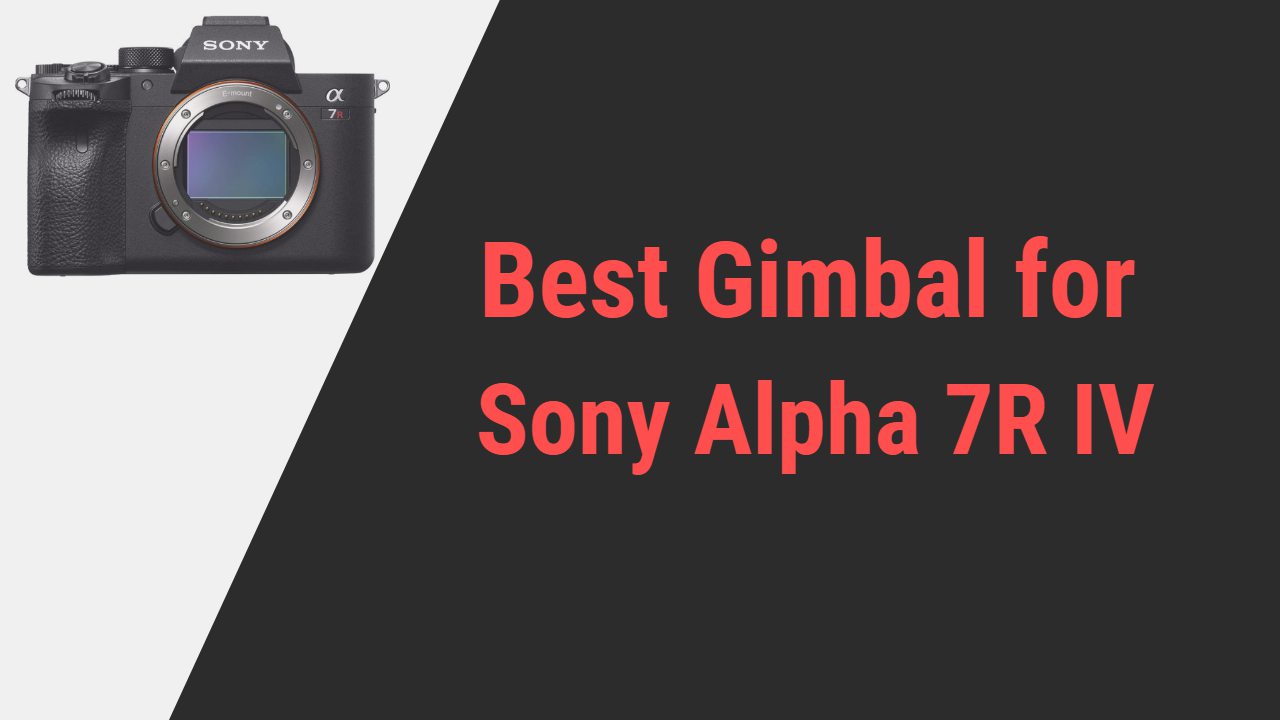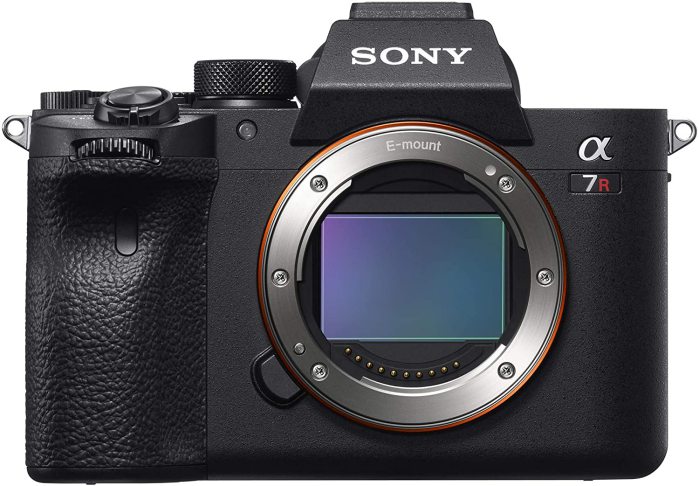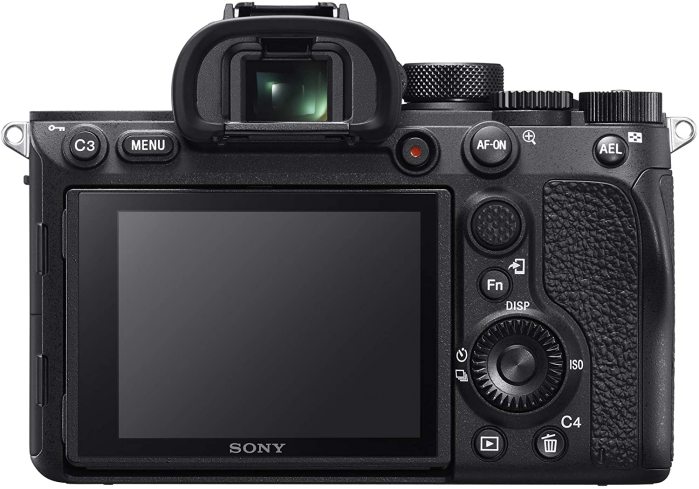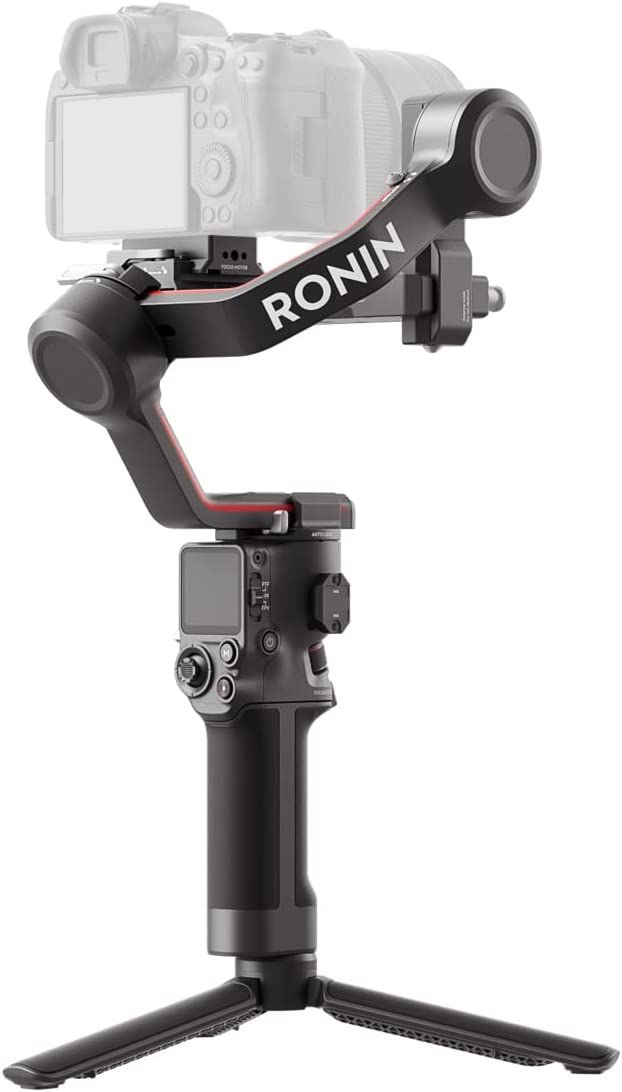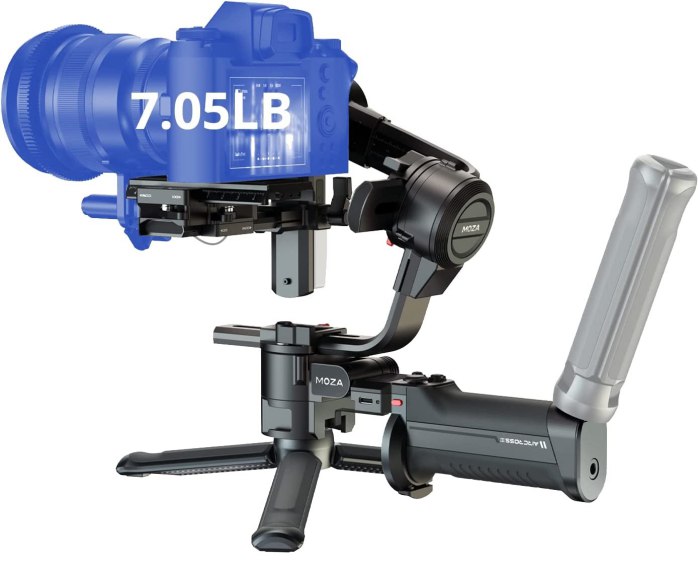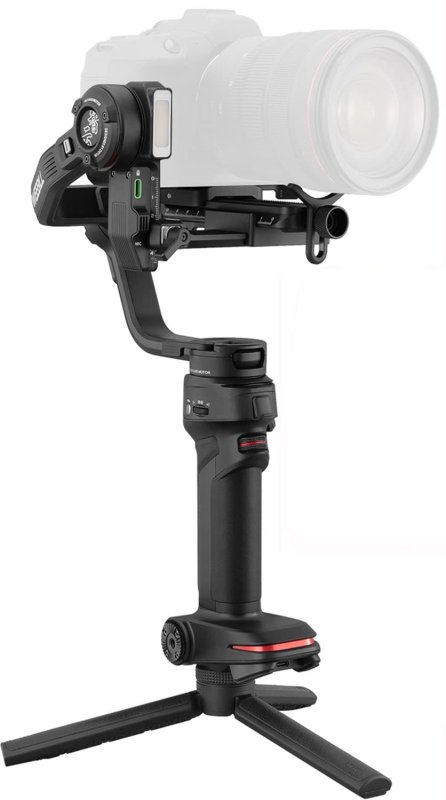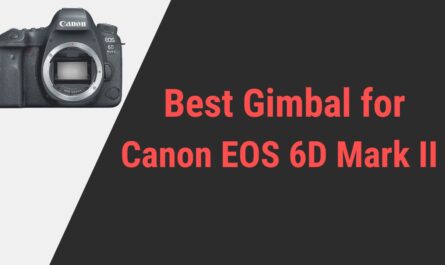By the strong virtue of design and functionality, the All-mighty Sony A7R has become the most loved and professional performing camera across the globe.
The 60 Megapixel A7R IV is destined with the glorious purpose of capturing images with remarkable clarity and details; However, while using the A7R IV, I experience a little greed in my eyes, wanting more of the enticement.
This is where I came up with my brilliant plan to get an ideal company of gimbals to my dearest A7R IV; this way, I could embrace deep in the world of cinematic filming without injecting tons of effort.
In terms of capabilities, nothing can question the unquestionable properties of A7R IV, which had me stand to the fact that the gimbal needed to be on an advanced level to match the camera standards.
Sony Alpha 7R IV
Note:
All the gimbals mentioned here are tested with Sony A7R IV and work perfectly fine.
| DJI RS 3 (Best Overall)

|
| DJI RS 3 Pro (Most High-end - Highest Payload Capacity & Comes with Advanced Features)
     |
| MOZA AirCross 3 (Budget Pick)
     |
| Zhiyun Weebill 3
     |
Now the whole market is flooded with tons of gimbals from different brands claiming their expertise as best for A7R IV, but when it comes to photography, you certainly can’t afford any risk.
So I have rounded off these four potent, fierce, and brilliant gimbals from some ethically reliable brands. These gimbals are classified with better picture quality, excellent handling, and modern design that would work as a charm to your A7R IV camera.
Let’s get you one of these beauties before attempting to shoot cinematic perfection.
Best Gimbals for Sony A7R IV
1. DJI RS 3
Overview– Starting with the Best, I am listing here one of my personal favorites at the top, the DJI RS 3 Gimbal. There is a reason why DJI RS 3 is on the top; you must be amused to learn the fact that this DJI masterpiece is something that can transform your shooting perspective.
You will get to confront the immense clarity and smoothness now with the most accessible handling and controls; what else could one want more? In short, do not worry if you don’t have any experience with gimbal usage; this DJI RS 3 is known for its straightforward controls and effortless operation.
Primary Characteristic
Payload– 6.6 pounds
Battery– 3000 mAh
Runtime-12 Hours
Weight– 2.4 pounds
Why did I pick DJI RS 3 for the Sony A7R IV?
There is something incredibly productive in DJI RS 3 I had felt even before the purchase; Later on, I had quite a time enhancing my filmmaking skill with the DJI RS 3.
The lighter and sleeker gimbal body feels not only proven healthy for comfort but also makes the ideal match with the Sony A7R IV camera body.
Additionally, the heavy professional vibes you will get with the DJI RS 2 is a smart complement to the top performer A7R IV and its in-built stabilization technique. Controls are not much of a challenging factor here, so the whole filming goes pretty well.
In-Depth Review
That’s, was the teaser of DJI RS 3 Features; let’s focus on what miracle its integrated intellectual can bring when paired with the A7R IV Camera; What are its creative abilities and specifications?
Inspired by the brand’s Primary motto, “Ready When you are,” the DJI RS 2 held the most quality performance and working. To work against the jerky bumps during filmmaking, it uses the upgraded next-generation stabilization algorithm in order to provide 20% enhanced stability over challenging shots.
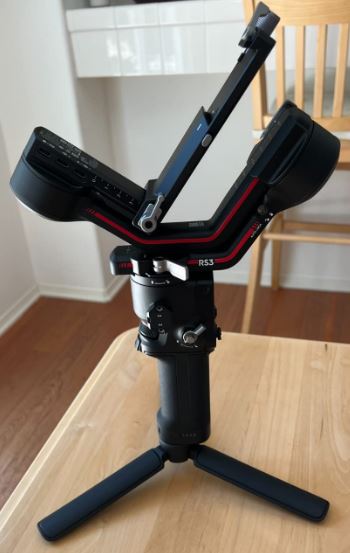

To back up that upgraded balancing, the gimbal uses the SuperSmooth Mode; this is something that works as magic. The Super Smooth mode leads to the increased motor torque value, which ultimately grants better steadiness over low-angle shots, fast-running subjects, or switching angle shots.
The gimbal is destined with a vast compatibility factor, saying it can be paired with maximum models; with the maximum 6.6 payloads, it also allows additional accessories to tag along.
Calibration keeps in our favor because whether you are an experienced or beginner, a quick-release mechanism with dual-layered plates is a much faster and more convenient method of mounting the camera on a gimbal.
The gimbal is famous for its effortless user interface and straightforward controls. It allows the user to access gimbals and even some of the camera setting parameters using wireless and wired control mediums.
The wireless controlling can be implemented through the Ronin Official application, which can use the secure and reliable pairing of Dual Mode Bluetooth connectivity.
And if we talk about the physical controls, the gimbal uses a few integrated, intuitive control dials, such as the fine-tuning knob that adjusts the camera position by sliding backward and upwards.
The rotatable dial at the front can adjust the focus and zoom, and it can be customized with other controls if required. At last, the simple slider allows one to switch the shooting modes to film creativity.
Talking about the modes, the gimbal is a master at catching brilliant shots at the trickiest angle and allowing different orientations to spice things up.
The gimbal allows filming multiple follow modes, 3D rotation, and roll along with multiple intelligent functions like Dolly Zoom, Motion lapse, Track, etc.
The whole controls and the gimbal operation can be monitored, All by the upgraded full Color OLED touchscreen panel with an 80% larger display through its 1.8-inch widescreen. The screen is rich with intuitive and precise controls and redesigned user interface.
Not just that, the gimbal also provides the Live Feed transmitted from 1080p at 30 directly to a mobile device using a rightfully effective transmitter.
For the very same purpose, the gimbal supports the Ronin Image Transmitter, which was previously known as the Ronin RavenEye image transmitter.
At last, the gimbal held the most creative design, attractive modern finishing, and contrast; The brand keeps the durability factor in mind while making the gimbal which is why high composite has been used.
While the weight of the gimbal will amaze you, the 2.4 pounds literally feels like nothing in hand while traveling.
Complementing the design, the gimbal uses the cartridge design to easily swap the batteries in the gimbal. The lithium-ion polymer batteries of the gimbal that charged 3000 mAh grant you 12 hours of filming with the promise of 2.5 hours of recharging period.
Bottom Line– At last, I prefer the DJI RS 3 because it can be very useful to beginners as well as professionals with its creative abilities and convenience factors. The price isn’t much higher to be an issue in the gimbal.
Pros
- Upgraded stabilization Algorithm
- Effortless controls and UI
- Never Better Performance and Monitoring
- Creative Intelligent mode shooting
- Improved Latch lock and calibration
- Decent payload and power
- 80% Larger display 1.8-inch OLED
Cons
- Lack of Durability I feel
2. DJI RS 3 Pro
Overview- Moving on, the party is just getting started; I have another wonderful gadget on the list coming up by the same brand but with an increased level of efficiency and upgraded approach of professionals.
Presenting you the Multi-functional, Top-rated performer DJI RS 3 Pro gimbal, a living upgraded model of DJI RS 3 with some serious intelligence and potential increment, all to uplift your mood with guaranteed heavy stability to your every footage.
The redesigned, refunctioned, and more powerful gimbal DJI RS 3 is all set to bring stabilized shooting adventure to you.
Primary Characteristic
Payload– 10 pounds
Battery– 1950 mAh
Runtime-12 Hours
Weight– 3.3 pounds
Why did I pick DJI RS 3 Pro for the Sony A7R IV?
There are a million factors I can list, but I am going to stick with professionalism. The DJI RS 3 PRO is unquestionably the most advanced tool I have ever seen, which I believe perfectly aligns with the Sony A7R IV’s abilities.
To complement the A7R IV 60 megapixel, the gimbal functions to prove better dark hour filming or videography by encouraging the other accessories company, 10 pounds payload is a compliment to add tools.
Also, the camera’s creativity gets fascinated with the gimbal’s upgraded stabilization, intelligence, and others, leading straight to the best result.
In-Depth Review
With some fascinating development in the field, DJI has modified the whole stabilization definition by indulging the greatest upgrades in the DJI RS 3 Pro gimbal. Along with the fashionable look and contrast, the gimbal body now encourages better durability.
Thanks to the carbon Fiber Construction, the gimbal weight became lightest at 3.3 pounds while the strength enhanced to the peak.
The gimbal uses the upgraded third-generation algorithm to provide 20% enhanced stability over the challengingly shaky shot. In addition, the DJI brand special Super Smooth mode ensures the buttery smooth flow caused by the increased motor torque to add quality in balancing through low-angle dynamic shots.
That was much similar to the previous edition; however, what is different is the DJI RS 3 Pro is known for effective stabilization with more features for an extensive scenario or coverage. This can be possible by the DJI RS SDK protocol.
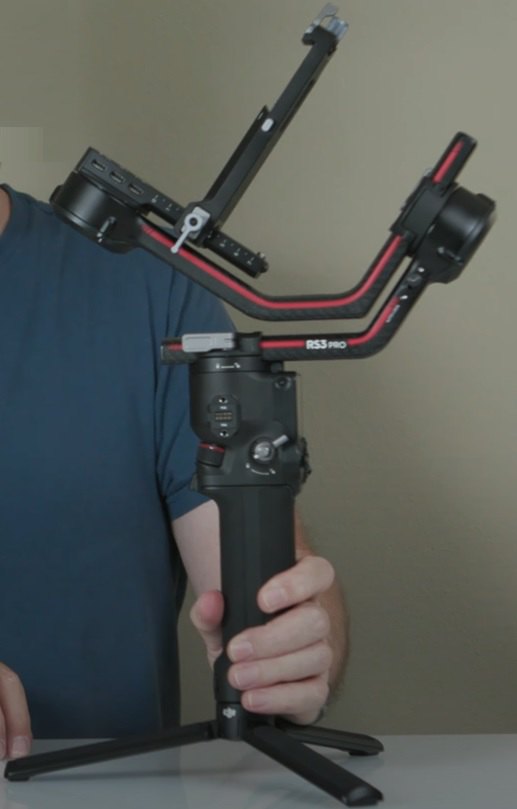

One of the other advanced features of DJI RS 3 Pro is it supports LiDAR Focusing, which means focusing while traveling or moving keeps getting better. With the Ronin 4D’s focusing technology, the LiDAR Range Finder projects 43200 ranging points to a certain area in order to procure more sharp details.
The gimbal has the highest payload, but did you know it makes things super spicy with the configuration of extensive ports for additional accessories, like the Dual RSA/NATO ports for the other accessories?
The gimbal is associated with many similar controls to the DJI RS 3, including the fine-tuning knob for camera positioning, Slider for mode switching, and a front dial for zoom or focus.
In Addition, DJI RS 3 Pro also includes a Teflon-coated component, which comes in handy for lowering the friction resistance to balance heavier mounted objects.
The gimbal proves its efficiency by allowing wireless control through the Ronin Official application. And you can’t forget the wonderful Active Track Pro creativity; the next-generation ActiveTrack Pro can put an eye on your subject by responsively tracking to wherever it goes.
The gimbal has the same 1.8-inch wide OLED Panel with the full fingertip touch control and redesigned user-friendly interface. But the gimbal also supports the High-Bright Remote monitoring, which allows precise control of the gimbal focus and stabilization using the Ronin 4D hand grips or master wheels.
Power also received an upgrade; there is no question about that; the gimbal is configured with the high-potent Lithium-ion polymer battery type that is charged with 1950 mAh, enough to grant 12 hours of constant working with the promise of 1.5 hours of recharging.
Bottom Line– Overall, you might notice there is no way a gimbal can perform so much innovation; The quality stabilization, quality creativity, and performance, you can add splendid transformative skills to your filming with DJI RS 3 Pro
Pros
- Highest payload, better stabilization
- Additional Port for accessories
- Advance LiDAR compatibility
- Extensive large coverage
- High-Bright Remote monitor support
- Strongest, heavily durable body
- Upgraded Active Track Pro
- Quickest charging time
Cons
- A little pricey if you ask
3. MOZA AirCross 3
Overview– It’s time to unfold the mystery of my flawless photography, and when I say flawless, don’t misunderstand it with a wallet filled with cash because I am pointing to the most affordable yet innovative three-axis gimbal here next on the list.
The design house of Moza has introduced this spectacular Aircross 3 handheld gimbal with an updated compact and ergonomic design than its predecessor only with enhanced features and innovation. Ideally for the regular, travel, or seven filmings, this Air Cross 3 gimbal is unquestionably one of the best options to choose from while holding the A7R IV.
Primary Characteristic
Payload– 7.05 pounds
Battery– 3500 mAh
Runtime-19 Hours
Weight– 2.9 pounds
Why did I pick Moza Aircross 3 for the Sony A7R IV?
There is a wide count list I could write down here why I have chosen this particular exception for my Sony A7R IV; this is because nothing satisfies the urge of an advanced camera’s expertise more than its equivalent leveled modern tool.
I literally found everything in Aircross 3 gimbal; that tool is literally the god of stabilized filming; however, my decision is biased because of its easy mounting and top-level security system.
Carrying such an expensive camera like A7R IV stresses me out a little while filming the trickiest angle, which is why Aircross 2, with quality security, seems the right fit with its 7 pounds payload. Also, the different creative modes aroused me a little and left me thinking about how I can use them to explore my 60-megapixel resolution of A7R IV.
In-Depth Review
The gimbal is designed with an advanced motor that has been improved enough to consume less power and grant more productivity. The motor provides upgraded stabilization to every and any dynamic shot.
In addition, the gimbal process with a Deep Red Algorithm makes the Aircross 3 much better at attitude controls and behavior prediction, all by means of enhancing the efficiency of the gimbal motor. Along with indulging singularity unlocking for higher level stability.
Tapping into the creativity, the gimbal allows the creation of the incredible quality image in different modes; this could be multiple follows including the pan follow, pan tilt follow, FPV, and so; The intelligent function mode time-lapse, panorama; the simple portrait to landscape mode and exceptions like the Inception mode and sports gear mode.
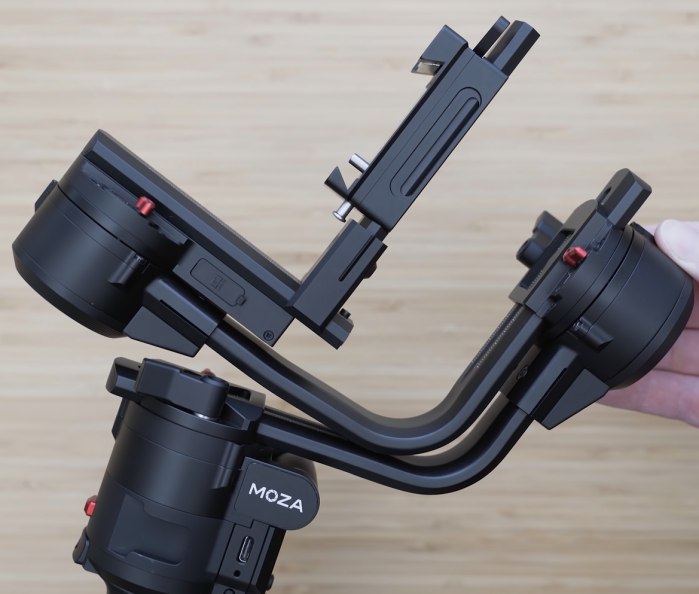

Mounting any camera on the top of the gimbal is not an issue with the quick-release system. The three-latch locking system keeps the securing of the camera as the first priority and manages the balancing. The gimbal follows two shoe mounts and three threads for the additional mounting options for the accessories.
Also, Manual position 2.0 can pull and drag the camera to a certain shooting position manually, which makes it simplest to switch angles while filming different orientations. It also allows easy and quick staying on and remembering of position for granting more stability during follow or sport mode.
The gimbal is designed with the modern fashionable structure approach, but at the same time, its structuring is made compact enough to favor the travel-friendly factor.
The foldable gimbal design allows the whole tool to fold down into the size of A4 paper, making it perfect for storing. The least weight of 2.9 pounds is compliment above all.
The controls of the gimbal are utterly straightforward; like any other gimbal, you can perform the remote controlling using Moza official application while other basic setting parameters are listed down on the engraved dials on the barrel.
The gimbal also includes an upgraded OLED display panel surrounded by an improved user interface and a high-tech graphic sidebar menu in the simplest layout, all to grant you ease while monitoring the gimbal behavior.
Being configured with the potent lithium-ion battery with 3500 mah power has benefited the gimbal with 19 hours of constant working within a single charge.
The gimbal also uses two separate USB-type charging assigned to the Type C port, ensuring the gimbal takes less than 1.4 hours to be fully charged. The gimbal batteries can be either charged with the power bank or also act as a power bank to your camera by adding extra hours of camera power.
Bottom Line– Haven’t you learned your lesson yet; you cannot find this high level of intellect at such a reasonable price and with the backup of such a reliable brand. What do you say? Ready to shoot some quality shots? Here is your key
Pros
- Three-latch locking system
- Improved Auto tuning AI
- Advanced deep red algorithm
- Better Manual Position 2.0
- Compact foldable designing
- Longest battery runtime
- One Step balancing
- Higher payload, least weight
- Quickest charging with USB port
Cons
- Controls might be challenging
4. Zhiyun Weebill 3
Overview– Last on the list, but certainly one of the most flexible, versatile, and intelligent ones. Possessing wonderful powers and dedication to craft steadiness in the picture, let me unveil the star Zhiyun Tech Weebill 3 gimbal with improved updates and a handful of creative approaches.
Coming from Zhiyun tech itself means a heavy dosage of intellect; however, this time, the brand focuses a little more on the gimbal design and photographer ease during usage. So, without further delay, let’s have a nice and deep look at its technological achievements.
Primary Characteristic
Payload– Not specified
Battery– 2600 mAh
Runtime-21 Hours
Weight– 2.2 pounds
Why did I pick Zhiyun Weebill 3 for the Sony A7R IV?
For uncountable reasons, actually, there is no way I am going to miss this superb gimbal while talking professionalism. Something as powerful as the Sony A7R IV can use Zhiyun’s wonderful expertise.
The gimbal has ravishing features and upgradation like the optimized stabilization, which is a plus factor for the in-built Camera stabilization but what is more creative is how Weebill 3 potentiality enhances the 60-megapixel shot imagery.
Even though A7R IV is announced with some compelling features, it somewhere gets attached to a hefty body that can cause trouble during the longest hour of filming, which is why Weebill 3 is essential for A7R IV.
In-Depth Review-
The Weebill 3 is certainly one of the most outstanding curations of Zhiyun Tech, with great features and design; I am going to start with the design first. So, the fascinating part of the Weebill 3 is its design.
The gimbal has the improved Sling 2.0 structure which not only gives a look but is effortless convenience for that matter.
Apart from that, the Weebill 3 is famed enough for its L-Shaped engineering, which allows the stabilizer to stand on its own over a flat surface without seeking any helping hands from any mini tripod. So that saves the hassle and budget.
The gimbal body is designed to be compact and least weighted so that it can conquer a perfect travel-friendly factor, which is pretty much achieved by the least 2.2 pounds weight, and the rest is taken care of by ergonomics.
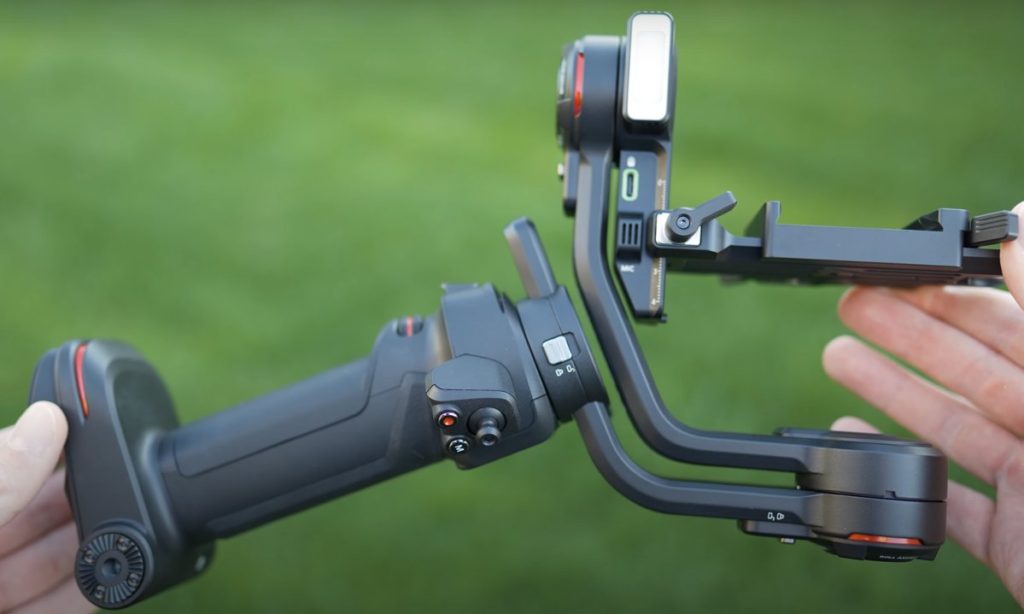

Like any regular gimbal, the Weebill 3 also uses the simplest quick-release system where the dual quick-release plates are determinant to mount and balance the camera while additionally, the Magnetic wrench embedded inside manages the security.
Even though the gimbal payload is not specifically mentioned, you can easily carry 5 to 6 pounds on the gimbal.
When it comes to stabilization, the gimbal is wrapped with the supreme and power-efficient motor that produces the optimized stabilization algorithm to the all-trickiest angle, low side, and dynamic or running subject shot.
The motor is responsible for shooting creative modes, including multiple follow, motion function, and others.
Another creative factor is the gimbal comes with an in-built microphone associated with the regular 3.5mm general audio port. This can be found pretty useful in Noise canceling, Hi-Fi, and cardioid recording during filmmaking.
Weebill 3 is considered a miracle for the dark-hour filming; this is all courtesy of Fill up lights that come with the gimbal. These fill-up lights contain 1000 lumens of brightness and color temperature that can be adjusted according to the need.
On top of that, the fill-up lights get the company of four colored filters; these filters bring a dramatic effect in every footage.
The gimbal didn’t encourage the challenging controls and stuck with the simplicity; It was associated with the simple wireless and physical dial controls.
So, the gimbal uses the trigger buttons to switch into different shooting modes, and then there’s another wheel control that can be used to adjust the setting parameters. Both the wheel control and the trigger can be customized accordingly.
And you can shoot the scene with remote practices and handling using any smartphone through the Zhiyun official application. Also, for monitoring purposes, the gimbal configuration includes a highly responsive OLED panel sized 0.96 inches designed with a better user interface.
Last but certainly not least, the gimbal is configured with a potent lithium-ion battery, three 18650 lithium-ion batteries that charge to 2600 mAh.
The batteries are trained to grant 21 hours of straight work within a single charge, along with the promise of quick recharging in 2 hours only.
Bottom Line- Summing up all, the Zhiyun Weebill 3 is the ultimate creation that can assure you the finest and most flawless-looking shots without engaging much effort. The quality, comfort, and intelligence all together get drawn in this masterpiece.
Pros
- Compact body and least weight
- No requirement for a tripod
- Improved sling 2.0 body
- Longest 21 hours of runtime
- In-built Fill-up lights and filters
- Optimized stabilization algorithm
- Easy calibration and axis lock
- In-built microphone for filmmaking
- Hassle-free control and handling
Cons
- Can fluctuate with heavy cameras
The difference I noticed using A7R IV with a gimbal
As much as I would like to say the A7R IV is an advanced camera with such a bright, functional side and promising abilities, there is always that one special tool that fits like the limp and enhances the efficiency of filming.
Gimbal does play that very same card in the A7R IV case. These gimbals are fascinating tools that can create a beautiful image without having to move around to a definite angle. These are well reversed to perform the magical stabilization in every footage using some high technology sensor and algorithm.
Being an A7R IV user for a long time has opened a vast creative opportunity in the filmmaking world, but my experience with the gimbal is quite different and uplifting if you ask. Here are some wonderful differences I sought using the Sony A7R IV with the gimbal.
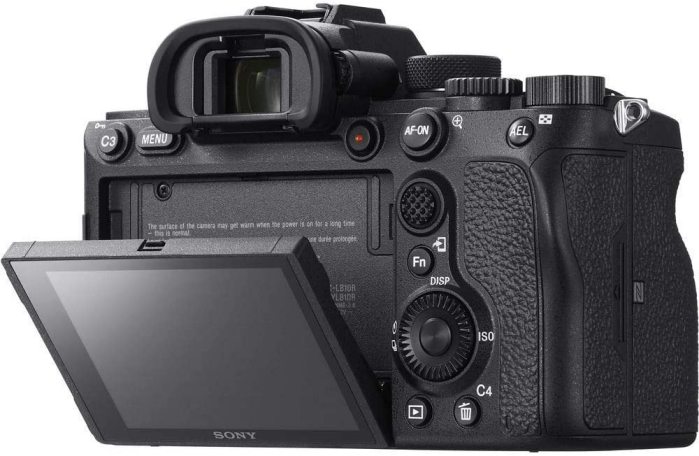

- The A7R IV 61-megapixel resolution can shoot much more sharp details of the subject or scenario in the surrounding.
- The sensor-shift five-axis stabilization of the camera gets a side backup of upgraded stabilization, locking up better balancing in videography.
- The camera’s in-built stabilization cannot do well in still photography, whilst the gimbal smooths the still picture as well.
- I do not have to hold the hefty magnesium alloy body with a 665-gram weight in a long filmmaking scene.
- A lot of the trickiest angles and modes can be discovered, and with the highest resolution of A7R IV, the results are just mesmerizing.
- The 2280 Mah battery of the A7R IV can now work forever with the backup of Gimbal’s strongest power source. Amazing right?
- The portability of the camera is now much easier, as locking it in a gimbal can ease the comfort.
- Also, I don’t have to stress out about my expensive A7R IV camera because the gimbal securely holds it and does the job.
- And don’t get me started on the quality; the smoothness, the balance, and the sharp details make the footage more cinematic.
How to get the best gimbal for an A7R IV camera?
The first thing that should be in your mind while buying a gimbal is, “Will this gimbal work with my A7R?” This only factor can decide the fate of your purchase.
However, there are some other crucial aspects that might need attention if you want to invest in the right place. So, to ease things up, I am going to list down those significant factors that grant the worthy purchase.
I am using the scenario for the Sony A7R IV, but it goes the same way for any other camera gimbal; so look a little more cautiously at this.
Compatibility– A professional camera like A7R IV doesn’t afford to be paired with any wrong gimbal, which is why camera compatibility is utterly necessary. Before the purchase, make sure the gimbal is setting fit with the A7R IV.
Payload– The A7R IV has a compact body with the least weight of only 665 grams, so you will need a gimbal that can afford that weight and still have room for other accessories as well. I looked for a gimbal that should have a 5+ pound payload.
Stabilization– The camera Sony A7R IV does have the sensor-shift five-axis stabilization, which works finest in photo and video; However, the little extra would never harm anyway. So, I have looked for upgraded stabilization that can make things better at balancing.
Weight– I don’t like to carry much hassle, which is why I would definitely go for the weight next. Before making up my mind, I cross-checked the gimbal with the least weight so that there shouldn’t be any strain on my hand or back during the long hour of filming.
Versatility– Apart from the stabilization, weight, and portability, what I really want from my gimbal is to embrace creativity which is why I would look for some innovations, display panels, and creative modes that can be shot using the gimbal; this will enhance my A7R IV productivity.
The advancement of the Photographer world: Sony A7R IV
As we move forward to an all-digital and technological era, the design house of Sony decided to launch something revolutionary; The total new experience of professional photographic expression can now be adaptable by the high performer SONY A7R IV.
Known for its impressively high speed, wonderful performance, and incredible skill of shooting still video and photo, this excellent full-frame Sony A7R IV is indeed something as powerful as you have ever seen.
Built with a reliable and intuitive processor and the greatest sensor, the camera’s internal operation goes on for landing over some higher resolution realm.
From the high-technology crowd of Sony experts, this masterpiece came out in the front in mid-July 2019. Featuring a black contrast and modular design, this camera holds exceptional power to cast miracles in the photography world. Some of the creative features it holds are better ISO, improved focusing, Shutter speed, exposure, and much more.
The camera is literally the God of innovation. The best part is it doesn’t stick to the highest price tag either; the brand launched this wonder with the tag of $3499 for the body only.
About Sony brand
Sony Group corporation has a fascinating fandom; Quite the star in the photography world, Sony is officially known as Sony Group Corporation. The brand has its origin in Minato Tokyo; it was initiated around 76 years ago, precisely in the year 1946.
The Japan-based multinational conglomerate corporation that is competent as the greatest technology company had their interest falls into the consumer and professional electronic products area.
Later on, the brand became the world’s largest manufacturer in no time by serving quality service across the globe.
The rapidly developing brand Sony is known and loved for its quality electronics while they have major talent in producing cameras, hardware, consumer electronics, entertainment, and much more. Sony stepped into the photography world by launching its very first camera in the 1980s
The prime characteristic of the Sony A7RIV
That was the theoretical appreciation of the Sony A7R IV; let’s get into the battlefield and look out for the exceptional creativity it guarantees with the purchase.
- Processor– The Sony A7R IV contains the highly potent, reliable, and responsive BIONZ X image processor with a record of impressively fast performance
- Imaging– The camera also has the company of R BSI CMOS sensor that is sized widely in full frame, granting you a 61-megapixel resolution to shoot stills
- Filming– The camera expertise in videography by filming ultra-HD 4K videos at 30p speed and full HD videos at 120p.
- Video recording– The camera has the potential to record marvelous shots with an in-built stereo to a certain limited range.
- Focus– The Sony A7R IV’s improved focusing includes both Auto and Manual focusing with the Automatic, continuous servo, single servo, and manual focus modes.
- Autofocus– The camera Autofocus has a sensitivity ranging from negative 3 to positive 20 EV with 567-phase detection and 425 contrast detection points
- ISO– The camera performs well in dark hours, with the help of Auto Iso, which works in both photo and video modes with different sensitivity
- ISO range– The ISO for Photo measured to be ISO 100 to ISO 32000, which can be extended to ISO 102400, and the ISO for Video measured to be ISO 100 to ISO 12800 in auto and ISO 32000 in manual mode
- Live-stream– With the vision purpose, the camera entertains having an in-built electronic OLED viewfinder sized 0.5 inches with 5.76M dot resolution, 0.78x magnification, and 100% coverage
- Display– The camera design includes a bright-high intuitive Tilting LCD touch screen with a 2359 K dot resolution and a size of 3 wide inches
- Shutter– The Sony A7R IV includes an electronic shutter that has a speed of 1/8000 to 30 seconds with better exposure modes,
- Exposure– The camera supports the aperture priority, manual, program, and shutter priority exposure mode
- Speed– The electronic shutter of the camera works with continuous shooting up to 10 frames per second speed
- Flash– The camera doesn’t have the in-built flash, but it has the S-TTL dedicated flash system for the external flash with Auto, fill, Hi-speed, red-eye reduction other flash modes supported
- Lens- This Sony camera has a body configuration with an E lens mount, which means the camera supports the Sony E lenses only
- Storage– The camera supports a dual slot for an SD card, which support both the SDHC or SDXC memory card formatted in UHS-II bus format.
- Stabilization– The camera comes with the sensor Shift Five-axis stabilization that uses five stops to compensate for the camera movement
- Interface– The Sony A7R IV encourages the Micro HDMI for video and a 3.5 mm Stereo audio interface along with the USB-C power interface.
- Connectivity– The camera can make a secure connection for data transfer through wireless Wi-Fi and Bluetooth technology
- Power– The camera is configured with a super powerful and long-lasting lithium-ion battery that can be recharged when needed.
- Runtime– The camera’s Li battery, charged to 2280 mAh, is empowered enough to shoot 530 constant shots within a single charge.
- Body– The SLR body type of camera turns out to be the strongest and sturdiest, composed of magnesium alloy and other traditional metals.
- Ergonomic– The fashionable contrast of the camera body contains heavy ergonomics, least weight of 1.46 pounds; the battery does come in the same
Frequently Asked Questions (FAQs)
How potent is the Sony A7R4 in the filmmaking world?
The answer you might already know; Sony A7R IV is one of the most intellectual precious jewels created by Sony; The brand has literally put all its expertise and professionalism into curating something as powerful. The camera holds a powerful processor, 61-megapixel resolution, and UHD 4K potentiality that contributes to a wise performance in the filmmaking world.
But that’s just the teaser; the camera is characterized by its impressive skill of still and video performance, and the better ISO, Focus, exposure, and white balance stuff gives a hand or two in achieving the being king title in the filmmaking world. The fashionable design, potent power backup, and least weight come complimentary.
Which gimbal tops the list for the Sony A7R IV?
I won’t bias my decision here in the recommendation, but I might say my choices of writing the gimbals depend on different characters. I prefer the DJI RS 3 Pro gimbal as the potent option for the Sony A7R IV camera; the upgraded stabilization of RS 3 Pro blends in and enhances the efficiency of the camera’s in-built stabilization.
Also, the gimbal 10 pounds payload grants freedom to accessorize the camera in order to shoot quality, and the 12 hours of power will act as the firmest backup for the A7R IV battery. So yeah, I think RS 3 Pro tops the list. However, if you are a little budget-conscious, Moza Aircross 3 or Weebill 3 can also do the job pretty effectively, if I may add.
Will the two-axis gimbal work with Sony A7R IV?
If we stick to the fact yes, the two-axis gimbal can do the job with the Sony A7R IV, but if you ask me, its probably be the most stupid idea to buy two ordinary-axis gimbals for something as powerful as a Sony A7R IV. The camera A7R IV, with its 60-megapixel resolution, needs large room for creativity, which certainly the two-axis rotator (Pan and roll) cannot provide.
And then there is the coordination; the high performance, speed, and quality working of A7R IV needed to be handled by something as professional as the camera, and a two-axis gimbal is definitely not an option here. Also, the hefty size of the A7R IV cannot be managed by Two compact axis gimbals, so no, it’s a bad idea to pair a two-axis gimbal to the A7R IV.
Do I need extra cash for Sony A7R4 gimbals?
A big no, Along with the comfort and creativity, the gimbal is well known for providing user convenience, whether it’s physical or financial. A gimbal is an innovative tool that doesn’t encourage high price tags. Getting an advanced gimbal for the Sony A7R IV might come with a higher budget than any other gimbal but certainly not that much.
Let me give you a peek at the budget. If you need a full-on professional tool for A7R IV, it will cost $799 to $899. If you can settle for the moderate-leveled gimbal, you wouldn’t have to spend more than $499, and then there is a third pocket-friendly option, where you can get a gimbal for under $399. So, NO, no need for big cash
Final Words
Is this the part where I say you have gathered enough of the details about picking up the ideal gimbal options from the market; One that makes your life easier and profitable with some wonderfully cinematic-looking shots?
The process of Buying a gimbal isn’t challenging, but the aspects that lead to a worthy purchase can be. Hopefully, you don’t have to go through that whole thing because I have got the best options right at your fingertips.
Nevertheless, one of the most crucial factors you should keep in mind while purchasing the gimbal is you have to keep the budget and need of the gimbal always in major consideration during the buying.
Remember, A7R IV is indeed a high-tech and expensive camera, but that doesn’t mean it requires something as expensive as it is. Not all expensive products will provide a better performance, this is your way, and you have to choose wisely.
Now wrapping up the article, I wish you luck in practicing better filming with a more professional approach this time; Get your A7R IV perfect companion of the gimbal and get on the track.
Share this article with someone who might need guidance and help aspiring photographers spread their wings.
Until the next time

